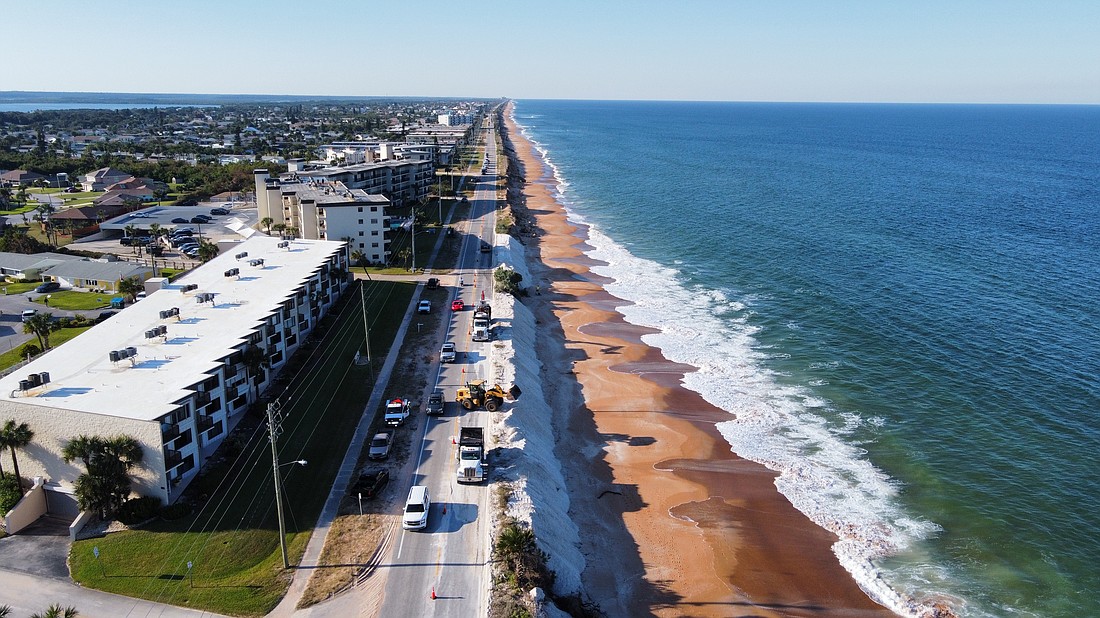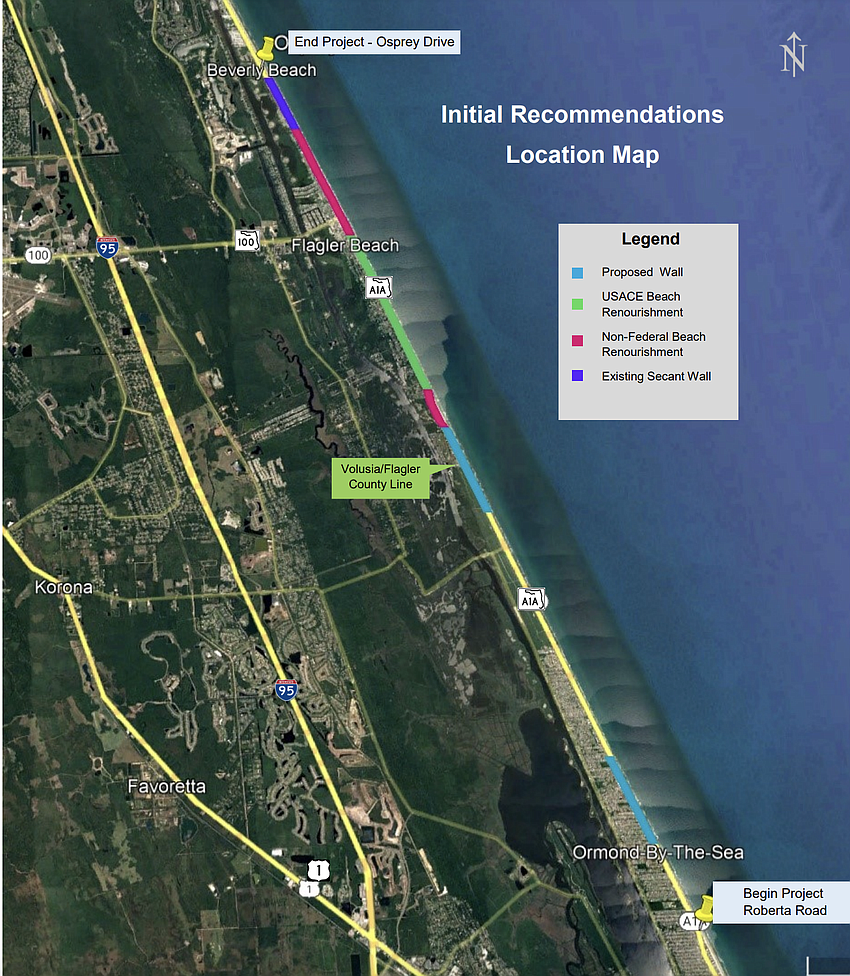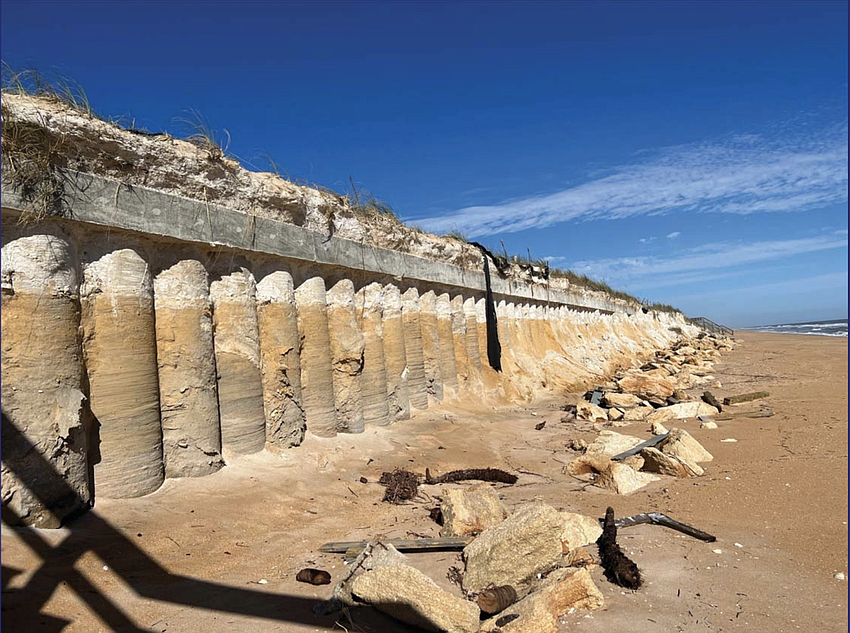- December 15, 2025

The Florida Department of Transportation is proposing a $100-million project to build two buried seawalls in sections of State Road A1A in Ormond-by-the-Sea and Flagler Beach in the wake of the recent hurricane season.
FDOT held an open house at The Casements in Ormond Beach on Wednesday, March 8, to discuss its resiliency plan for the 13-mile corridor between Roberta Road in Ormond-by-the-Sea and Osprey Drive in Flagler Beach.
The recommendations by the S.R. A1A Resiliency Strike Team — composed of representatives from Flagler and Volusia counties, Flagler Beach, the Florida Department of Environmental Protection, FDOT and the Army Corps of Engineers — were proposed a couple of months after FDOT held a series of community listening sessions in January to gather citizen input on the repair options.
The buried seawalls, referred to as “secant walls” by FDOT, would be constructed from Sunrise Avenue to Marlin Drive in Ormond-by-the-Sea, and from half a mile north of Highbridge Road in Ormond-by-the-Sea to South Central Avenue in Flagler Beach. The first wall would span 1.28 miles; the latter 1.3 miles.
“We are pursuing an extremely aggressive schedule. They understand the need." — JACK ADKINS, FDOT’s District 5 director of transportation development
FDOT spoke to the Flagler Beach City Commission on March 9 about the proposed sea walls and will also hold an open house at the Wickline Center in Flagler Beach on March 21.
FDOT District 5 Director of Transportation Development Jack Adkins told the Flagler Beach City Commission that the Strike Team is working with the Federal Highway Administration to get the project moving.
“We are pursuing an extremely aggressive schedule,” Adkins said. “They understand the need.”
District 4 Volusia County Council member Troy Kent said he’s pleased that the state has realized it needs to take action.
“If you have a couple of back-to-back storms like we did, that secant wall will stop the hemorrhaging,” Kent said. “The secant wall will stop it to where, OK, it’s gotten to this point, and it’s going to save the road and it’s going to save the homes and businesses on the west side of A1A.”
Some environmentalists, however, argue that the proposed secant walls would only protect the road, not the beach itself.
Melissa Lammers, a board member of Halifax River Audubon and Audubon Florida, said in a statement that even if FDOT’s secant walls are a “done deal,” county government should still commit to maintaining the dunes on the beach.
“The technology they’ve chosen, the secant wall, is a method to shore up vertical excavation walls for earthwork supported roads,” said Lammers, who is also a member of the Environmental Council of Volusia and Flagler Counties. “It’s not a method for beach preservation. Armoring the coast with things like seawalls and secant walls will speed up erosion: Waves will scour the beach directly in front of the wall and any un-armored areas on either side.”
FDOT has been performing emergency repairs and fortification in the project area of A1A since 2002, according to FDOT’s presentation.
The work has cost over $39 million — not counting the money Volusia and Flagler counties spent to repair walkovers and beach access points, or residents’ losses after storms.
Since the recent hurricanes, FDOT has spent an additional $15 million so far to repair A1A and strengthen the coastline. FDOT contractors have placed 53,294 cubic yards of sand and 38,272 tons of rock.

Constructing the walls will be expensive, but worth it, Kent said. He would like to see a secant wall built throughout the entire project area.
“I think that the cost is huge, but it’s nowhere near the cost of losing A1A and having to continue to rebuild that road,” Kent said. “And it’s nowhere near the costs of losing homes and losing businesses, so it is a needed measure, unfortunately.”
While he hopes the area gets a break from storms so that the dunes can replenish naturally, Kent noted that the dune areas that fared best in Volusia County were those with considerable vegetation, such as scrub and sable palms. He recommended that FDOT plant vegetation on the impacted dunes.
FDOT Strategic Initiatives Manager Catalina Chacon said during the Flagler Beach meeting on March 9 that FDOT is exploring what state and federal funding is available for the walls.
Flagler Beach Commission Vice Chair Rick Belhumeur said that Flagler Beach has one buried sea wall already, and its dune has been washed away for some time and not yet replaced.
Chacon told the commission FDOT is working on a maintenance program as part of the proposal, including covering the wall where it has been exposed.
“It probably will get exposed at some points; it’s inevitable,” Chacon said. “But we are working on a maintenance plan — who, how, how often, where’s the funding going to come from.”
People submitted more than 100 written comments during FDOT’s listening sessions in both Ormond Beach and Flagler Beach.
Residents said they favor options that would maintain the corridor’s natural beauty while protecting the beach, FDOT stated in its presentation. Locals also want more public walkovers and pedestrian crossings and lower driving speeds, and support the 2.6-mile Army Corps of Engineers beach renourishment project which is moving forward in Flagler County and has been in the works since the Corps secured funding in 2018.

In addition to beach renourishment projects — which Volusia County also has expressed interest in pursuing — FDOT identified two other options to fortify dunes.
The first option is a granite revetment. The environmental impact of a revetment would be a big drawback: It would reduce the width of the beach and impact sea turtle nesting.
The second option is to construct buried sheet pile walls, but FDOT noted that sheet pile walls are unsuitable for areas that have a shallow rock layer or large variations in elevation.
The recommended secant walls, however, have low environmental impact and can be built in areas with a shallow rock layer, FDOT stated in its presentation: One was constructed in Flagler Beach from North 18th Street to near Osprey Drive.
The only disadvantage, the presentation noted, is that secant walls are the costliest option of the three.
While Lammers, of Ormond-by-the-Sea, said it was good that FDOT held open houses to present its plans, she added that the format didn’t allow for much public discourse. Citizens couldn’t hear questions asked by their neighbors, nor how FDOT’s Strike Team responded.
“We can’t really make an informed decision under those conditions,” she said. “Comments on social media show that the public mistakenly believes that FDOT is going to protect the beach. FDOT’s mandate is to protect S.R. A1A, not the beach.”
Ormond Beach Mayor Bill Partington called the proposed FDOT project “forward-thinking.”
“Even though, technically, it may not be in Ormond Beach, our residents use that road to get to places, and so it’s important,” he said. “It’s important to the entire area.”
Resiliency is the key word for FDOT, he added.
“Basically, understanding that we’re experiencing these weather events are stronger than what we’ve dealt with in the past,” Partington said. “They’re adapting and planning for that.”
The secant walls, Kent said, strike the balance between preserving the beach and preserving A1A.
“It’s not a situation that anybody wants to be in, but we’re in it,” Kent said. “So now that we’re in it, I want something in place that is going to stop the destruction of our A1A roadway and the businesses and homes, because that’s what will be next. ... We have to make the tough decision to say, ‘Hey, we’re going to put something in place,’ so that we draw a line in the sand.”
Lammers said that since at least 2016, Volusia County has relied on FDOT to try to protect the beaches on the north end of the county. But that’s not FDOT’s responsibility, she said. The county needs to monitor and find funding for future beach renourishment and dune revegetation programs beyond what FDOT proposes.
“For years, portions of Volusia County beaches have been deemed critically eroded by the Florida Department of Environmental Protection,” Lammers said. “If we want to have a beach and not just a road next to a beach, the time to act is now.”
This story was updated at 10:45 a.m. Tuesday, March 14, to include comments by local environmentalist Melissa Lammers.